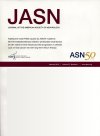Interplay between Skeletal Muscle Catabolism and Remodeling of Arteriovenous Fistula by Yes-Associated Protein 1 (YAP1) Signaling
Atrophied muscle–derived myostatin stimulated mesenchymal stem cell differentiation and adverse arteriovenous (AV) fistula remodeling through yes-associated protein 1 (YAP1) activation.Treatment with myostatin peptibody inhibited muscle wasting and blocked mesenchymal stem cell activation and AV fistula fibrosis.A light-sensitive drug-release strategy was engineered for the periadventitial delivery of verteporfin to improve AV fistula patency.
Background
Arteriovenous (AV) fistulas are the preferred access for dialysis but have a high incidence of failure. The aim of this study was to understand the crosstalk between skeletal muscle catabolism and AV fistula maturation failure.
Methods
Skeletal muscle metabolism and AV fistula maturation were evaluated in mice with CKD. The roles of myostatin and yes-associated protein 1 (YAP1) in regulating the transdifferentiation of adventitial mesenchymal stem cells (MSCs) and intima hyperplasia in AV fistula were investigated. Nanoparticles carrying a YAP1 inhibitor, verteporfin, with light irradiation–controlled release were synthesized and applied to AV fistula.
Results
Increased trichrome signals and stenosis were observed in AV fistulas from mice treated with myostatin and from mice with CKD. By contrast, blocking myostatin function with an anti-myostatin peptibody not only improved body weight and muscle size in CKD mice but also decreased neointima formation in AV fistulas. In cultured MSCs, myostatin induced YAP1 expression, promoting the differentiation of MSCs into myofibroblasts and inducing extracellular matrix deposition. Red light irradiation–controlled release of verteporfin from nanoparticles blocked YAP1 activation and alleviated myostatin-induced MSC activation. Periadventitial application and red light irradiation of nanoparticles carrying verteporfin significantly suppressed stiffening and neointima formation in AV fistula.
Conclusions
CKD induced muscle wasting, leading to increased production of myostatin, which stimulated MSC activation and vascular fibrosis linked to AV fistula stenosis. YAP1 signaling was activated in these processes. Red light irradiation–controlled release of verteporfin offered a feasible approach for local vascular drug intervention to improve AV fistula maturation.




